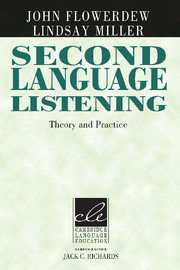Book contents
- Frontmatter
- Contents
- Series editor's preface
- Preface
- Acknowledgments
- Part I HISTORICAL BACKGROUND
- Part II A PEDAGOGICAL MODEL AND ITS APPLICATION
- Part III KEY ISSUES IN TEACHING AND TESTING
- 9 Developing Listening Skills through Technology
- 10 The Role of Questions in the Teaching of Listening
- 11 Testing Listening
- Appendix: Concluding Questions for Reflection
- References
- Index
10 - The Role of Questions in the Teaching of Listening
Published online by Cambridge University Press: 04 February 2010
- Frontmatter
- Contents
- Series editor's preface
- Preface
- Acknowledgments
- Part I HISTORICAL BACKGROUND
- Part II A PEDAGOGICAL MODEL AND ITS APPLICATION
- Part III KEY ISSUES IN TEACHING AND TESTING
- 9 Developing Listening Skills through Technology
- 10 The Role of Questions in the Teaching of Listening
- 11 Testing Listening
- Appendix: Concluding Questions for Reflection
- References
- Index
Summary
Introduction
A major aspect of any language-teaching methodology is how the teacher checks comprehension. Often, this is done by asking students questions based on the texts. In listening, there is no simple correlation between the student's answering a question correctly and the level of comprehension achieved by the student. As we will illustrate in this chapter, depending on the way the question is asked, and the type of response accepted, listeners can demonstrate a wide range of comprehension ability. Where it is clear that they have not understood, this provides an indication of where teaching intervention is needed. It is through the teacher's skillful use of different question types and formats that learners are guided to develop effective listening.
Teaching listening has often been confused with testing listening. As questioning plays a major role in listening tests, teachers have often focused on preparing learners for tests in class instead of helping them develop effective listening skills. While reading the rest of this chapter, the reader should keep in mind that we are talking about teaching listening, not testing listening. Testing listening skills is the subject of Chapter 11.
Models for Integrating Questions While Teaching Listening
In the early language-teaching methods, the focus was very much on finding out how much information the listener could recall through direct questioning. In this product approach (Figure 10.1), the spoken text was presented, listeners “paid attention” to the message, and they were asked questions to check their comprehension. If they did not respond correctly to the teacher's questions, the tape was often played again, and again.
- Type
- Chapter
- Information
- Second Language ListeningTheory and Practice, pp. 184 - 197Publisher: Cambridge University PressPrint publication year: 2005



